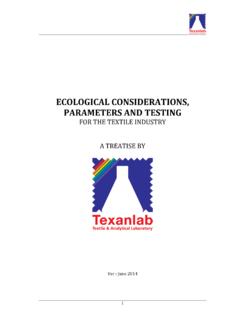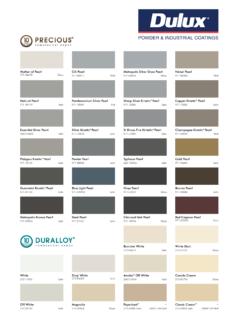Transcription of Colour fastness to washing - Texanlab
1 Texanlab Laboratories Pvt. Ltd. Colourfastness Testing Series Colour fastness to washing 1 Test Titles : Color fastness to Domestic and Commercial Laundering (ISO 105 C06) Color fastness to Domestic and Commercial Laundering using a non-phosphate reference detergent incorporating a low temperature bleach activator (ISO 105 C08) Color fastness to Domestic and Commercial Laundering-Oxidative bleach response using a non-phosphate reference detergent incorporating a low temperature beach activator (ISO 105 C09) Colourfastness to Laundering, Home & Commercial : Accelerated. (AATCC 61) Color fastness to washing is the common quality parameter, which is considered very important from the point of view of consumers. This test determines the loss & change of Colour in the washing process by a consumer and the possible staining of other garments or lighter portion that may be washed with it.
2 This test is used to predict the performance of any dyed or printed textile product to the common washing process using a detergent and additives. Some of the test conditions in ISO and all the AATCC conditions are designed to simulate the behaviour of the textile after 5 domestic or commercial launderings. B) Test Methods: ISO 105 C06 / C08 / C09 & AATCC 61 While the most common test methods that are currently followed are ISO 105 C06 and AATCC 61, newer test methods such as ISO 105 C08 and C09 replicate washing with the addition of non-chlorine bleaches and low temperature bleach activators. The specific conditions for these tests are given in Table 1. Test Equipment and Consumables: Wash wheel Standard reference detergents without Optical Brighteners either ECE or AATCC 1993 as specified by the standards. Multifibre Fabric Stainless Steel Balls Bleach & Bleach activators Grade 3 Water Assessment facilities Colour fastness TO washing Texanlab Laboratories Pvt.
3 Ltd. Colourfastness Testing Series Colour fastness to washing 2 Wash wheel pots and stainless steel balls AATCC & ECE Standard Reference Detergents AATCC Style 10 Multifibre Fabric Spun Diacetate Bleached Cotton Polyamide Spun Polyester Spun Acrylic Worsted Wool SDC DW Multifibre Fabric Acetate Cotton Nylon Polyester Acrylic Wool Texanlab Laboratories Pvt. Ltd. Colourfastness Testing Series Colour fastness to washing 3 C) Procedure in Brief : Specimens are cut either in 4 x 10 cm size (ISO) or 5 x 10 cm for AATCC 61 1A or 5 x 15 cm for other AATCC 61 methods. (See figure). A multifibre swatch is attached to the specimens. Care must be taken to ensure all colours in the specimen are covered in the test in some cases multiple specimens may be necessary for this. A wash liquor is prepared using Grade 3 water, the appropriate detergent and additives. The detergents that are specified are the ECE standard reference detergent WOB and AATCC Standard Reference Detergent 1993 WOB.
4 The composite specimen + multifibre is placed in the wash wheel pot containing wash liquor, with additives and steel balls as may be required. The wash wheel is then run for the appropriate time duration. The specimens are then removed, rinsed and dried in still air at temperatures not exceeding 60 C. Once dry and conditioned, assessment is carried out. Tested samples being dried D) Assessment / Results and Interpretation Colourfastness to washing is assessed in three ways : Change in shade loss of Colour or tone as compared to the original unwashed sample Extent of staining on the multifibre sample. Self staining if any. Standard grey scales are used for the assessment where grades between 1 and 5 are given in half steps. Assessment needs to be done with clean grey scales using masks and under standardized lighting conditions in a dark room. Texanlab Laboratories Pvt.
5 Ltd. Colourfastness Testing Series Colour fastness to washing 4 Grey Scales for assessment Assessment being done in standard lighting conditions E) Case studies: Several conditions during dyeing and printing of a fabric may contribute to loss or change of Colour and the transfer of the color during washing but the two main causes of poor colourfastness to washing are - Improper fixation of the dyestuff on the fabric surface. Improper removal of unfixed dye. Texanlab has investigated a great number of complaints both from the industry and consumers with regard to wash fastness problems over the past 23 years. Some of these are given below - Sample of rug showing shade change and staining in the colourfastness to washing test. Texanlab Laboratories Pvt. Ltd. Colourfastness Testing Series Colour fastness to washing 5 Case Study 1 : Importance of Understanding Garment Construction.
6 Colourfastness specifications are based on experiences of Buyers and cover most garments. However, there are cases where even though colourfastness was within the specification, there were customer returns and a claim. In one case we found a Reactive Dyed Cotton Fabric in a bright red shade. This fabric had passed the Buyer s colourfastness to washing test with a staining on cotton rating of which is normally considered excellent. However, a rating of 4-5 also indicates that very slight staining of adjacent multifibre has taken place. The garment that was produced out of this fabric was fashioned as a long ladies dress with a tiny white cotton collar. On washing , consumers found that the white collar had picked up a pink tint and returned the garment. It is useful here to note that the multifibre strip used in the colourfastness to washing test is the same size as the specimen while in this consumer s case, the proportion of the coloured material to the white collar was much higher.
7 Therefore, the collar picked up much more Colour than the cotton portion in the Multifibre strip in the laboratory, leading to staining corresponding to a rating of 3 on the grey scale and hence the claim. In this case, even though the fabric had acceptable colourfastness properties as per specifications when tested in a laboratory, the styling of the garment that was created out of it necessitated that the requirement should have been rating 5 only. Standard test methods are a barometer for assessing the level of colourfastness but the results obtained from a test needs to be interpreted by a competent fabric technologist with proper understanding of the use of the fabric in manufacturing the end product and the wash care instructions recommended. Case Study 2 : Poor fastness of Accessories: It is not only important to have the base fabric color fastness satisfactory but also it is necessary to ensure that all the accessories that go into making a fashion garment meet the minimum requirement.
8 In today s export scenario almost all Ladies/ girls/ kids T shirts/ tops have some embellishments and trims such as piping, lace, embroidery, tapes, buttons etc. Many of which are coloured / dyed. Since these quantities are invariably very small compared to the base garment, due care is not given either in their procurement or dyeing. A case seen by us involved a dressing gown for ladies, which had a satin tape embellishment. While the base fabric was found to have excellent colourfastness to Texanlab Laboratories Pvt. Ltd. Colourfastness Testing Series Colour fastness to washing 6 washing properties, the satin tape was found to have very poor colourfastness which ruined the garment. Garment as manufactured Tested specimens showing excellent colourfastness to washing of main fabrics but very poor fastness of the satin tape trim. Case Study 3 : Faulty finishing & Faulty supply of chemicals A pigment printed fabric showed extremely poor colourfastness to washing .
9 This was quite unusual, since pigment printed goods are expected to show excellent colourfastness to washing properties. Investigation revealed that the pigment printing was carried out properly, with use of the correct recipe, components and curing techniques. A more detailed study found that the base fabric on which printing was being carried out was a finished fabric and was given a softener treatment. The waxy softener acted as a barrier preventing adequate adhesion during printing. In this case, the problem was solved by advising the manufacturer to use an unfinished fabric. Texanlab Laboratories Pvt. Ltd. Colourfastness Testing Series Colour fastness to washing 7 Colourfastness to washing specimen showing unacceptable loss of Colour due to faulty finishing of the base fabric. This shows the importance of good understanding that is necessary across the supply chain since the fabric manufacturer had unnecessarily added expensive softener which in fact proved detrimental to the subsequent process.
10 Many years ago we were presented with another pigment printed fabric with poor fastness to washing . While studies showed that here there was no problem of finishing or of the recipe, but we found that the catalyst supplied to the printer was not of the right quality or grade which led to little or no fixation on the fabric and hence the poor colourfastness. Unfortunately, many thousands of meters of fabric was already printed before this problem was noticed, which led to substantial losses. This serves as a reminder to processors to check all incoming products for quality before using them on the shop floor. Conclusion The test for colourfastness to washing is one of the most basic colourfastness tests used by customers to evaluate end products. The processor is required to understand the product and its requirements so as to select the colouration techniques and processes accordingly.







